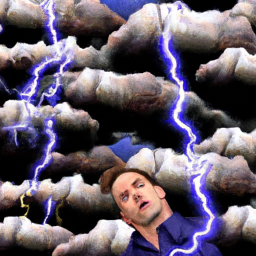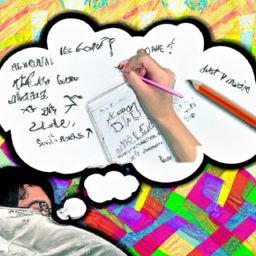Have you ever had a dream that felt incredibly lifelike? One where upon waking up, you question whether it actually happened or if it was just a product of your imagination? I definitely have, and I must say, it’s quite a strange feeling.
It’s like trying to distinguish between a painting and a photograph – they both look real, but one is a creation of the mind.
Dreams that feel real are quite common, yet many people don’t fully understand their significance. Personally, I’ve always been fascinated by the messages and symbolism within my vivid dreams.
Whether they are a reflection of my subconscious mind or a prophetic glimpse into the future, I believe they hold valuable insights that can help guide us in our waking lives.
So, let’s dive into the world of dreams and explore what it means when they feel all too real.
Key Takeaways
- Vivid dreams can feel very realistic and sensory, and are influenced by emotions and external stimuli.
- The brain processes information differently during REM sleep, leading to vivid dreams that can evoke strong emotions and help process memories.
- Common themes in vivid dreams include flying, falling, being chased, or intense emotions, and they can be symbolic of our experiences and emotions in waking life.
- Techniques for enhancing dream vividness, such as keeping a dream journal, reality checks, and lucid dreaming, can help us gain insights into ourselves and promote personal growth.
Understanding Dreams
Dreams can be confusing, but understanding them can be exciting! They’re a series of thoughts, images, and sensations that occur in the mind during sleep. They can be influenced by our memories, experiences, emotions, and even our subconscious desires. Dreams can be vivid, bizarre, or ordinary, and they can be difficult to interpret.
One theory about dreams is that they’re the brain’s way of processing and consolidating information. During sleep, the brain organizes and stores memories, emotions, and experiences from the day. This process can sometimes lead to vivid dreams that feel real.
These dreams can be so intense that they can cause us to wake up feeling disoriented or emotionally charged. But what does it mean if your dreams feel real?
What are Dreams That Feel Real?
I’ve always been fascinated by dreams that feel real. It’s incredible how vivid and lifelike they can seem, almost as if I’m experiencing them in real life.
In this section, we’ll explore the characteristics of these types of dreams and the science behind why they feel so realistic.
Characteristics of vivid dreams
When you wake up feeling like you’ve just experienced a wild adventure, it’s a sign that your mind conjured up some pretty vivid dreamscapes. Vivid dreams are those that feel incredibly realistic, almost as if you were living through them in real life. They often involve detailed sensory experiences, with sights, sounds, smells, and even physical sensations that feel genuine.
Some of the characteristics of vivid dreams include heightened emotions, increased realism, and greater complexity. In these dreams, you may find yourself fully immersed in a different world, with a clear sense of place and time. You might encounter people you know, or even those you’ve never met before, and experience conversations and interactions that feel genuine and meaningful.
All of these elements combine to create a dream that feels so real, it can be hard to shake off even after you wake up. Understanding the science behind vivid dreams can help shed some light on why they happen, and what they might mean for your waking life.
The science behind vivid dreams
Get ready to dive into the fascinating world of vivid dreams and discover the scientific explanation behind why our minds conjure up such incredibly realistic experiences while we sleep.
The science behind vivid dreams is a complex and fascinating topic that has been studied for decades. One theory is that the brain processes information differently during REM (Rapid Eye Movement) sleep, the stage of sleep where most vivid dreaming occurs.
During REM sleep, the brain becomes more active, while the body becomes paralyzed, which allows the brain to create vivid and immersive dream experiences. Another theory is that vivid dreams are a way for the brain to process emotions and memories.
During the day, we experience a wide range of emotions and events, and our brains need time to process and make sense of them. Vivid dreams may be a way for the brain to categorize and store these experiences, helping us to better understand our emotions and experiences when we wake up.
Understanding the science behind vivid dreams can help us appreciate the incredible abilities of the human brain. Now, let’s explore common themes in vivid dreams.
Common Themes in Vivid Dreams
Typical themes in vivid dreams often include flying, falling, being chased, or experiencing intense emotions. These themes are common because they are all related to our deepest fears and desires.
For example, flying dreams often represent a desire for freedom or the ability to rise above a situation. Falling dreams, on the other hand, often represent a loss of control or a fear of failure.
The intensity of emotions in vivid dreams can also be a common theme. Dreams can evoke powerful emotions such as fear, sadness, joy, or anger, and these emotions can feel just as real as they do in waking life. In fact, some people may even wake up feeling emotionally drained or overwhelmed by a particularly vivid dream.
Understanding the role of emotions in vivid dreams can help us better understand ourselves and our deepest fears and desires.
The Role of Emotions in Vivid Dreams
Experiencing intense emotions in vivid dreams can be a truly overwhelming and unforgettable experience. I’ve had dreams where I felt extreme fear, sadness, anger, and even joy. These emotions can feel just as real as they do in waking life, and can linger long after I wake up.
It’s amazing how the brain can create such vivid and detailed scenarios that evoke such strong emotions. But what causes dreams that feel real? There are several factors that can contribute to the intensity of a dream, such as stress, anxiety, and certain medications.
Additionally, the brain’s processing of emotions during sleep can enhance the emotional intensity of a dream. It’s fascinating to explore the various elements that can make a dream feel so vivid and real.
What Causes Dreams That Feel Real?
As I mentioned earlier, emotions play a significant role in the vividness of our dreams. However, there are other factors at play as well.
Have you ever had a dream that felt so real that you woke up questioning whether it actually happened? This can happen for a variety of reasons and is often linked to the level of brain activity during sleep.
When we enter the rapid eye movement (REM) stage of sleep, our brain becomes highly active and is essentially creating a movie in our mind. This activity can be so intense that it can cause our brain to create a dream that feels real.
Additionally, external stimuli such as noise or light can also impact our dreams and make them feel more lifelike.
Our brain activity during REM sleep plays a significant role in creating vivid dreams. External stimuli such as noise or light can also impact the intensity of our dreams. Dreams that feel real can be caused by a combination of these factors.
Now, let’s move on to the next topic and explore the symbolism of vivid dreams.
The Symbolism of Vivid Dreams
Let’s explore the symbolism of vivid dreams and how they can provide insight into your subconscious thoughts and emotions.
Vivid dreams are often full of symbolism, representing different aspects of your life, experiences, and emotions. For example, dreaming of a snake can symbolize fear or danger, while dreaming of flying can symbolize freedom or a desire for escape. These symbols can help you understand your deeper feelings and desires, even if you may not be consciously aware of them.
Furthermore, vivid dreams can also provide a form of self-reflection. They allow you to explore different scenarios and emotions without the consequences of real life. This can be a powerful tool for personal growth and understanding.
By analyzing the symbols and themes within your dreams, you can gain a better understanding of your innermost thoughts and feelings. Understanding the symbolism of vivid dreams can ultimately lead to a greater understanding and acceptance of oneself.
The Significance of Vivid Dreams
You can’t help but feel a sense of wonder and awe at the significance of your vivid dreams, as they offer a glimpse into the mysterious workings of your subconscious mind. When your dreams feel real, it’s an indication that your mind is trying to convey a message to you, or perhaps help you process unresolved emotions or experiences.
These dreams can be incredibly powerful, and can leave a lasting impact on your waking life. The significance of vivid dreams lies in their ability to provide insights into aspects of ourselves that we may not be aware of in our waking state. By paying attention to the symbols, emotions, and themes that arise in our dreams, we can gain a deeper understanding of our inner world and the forces that shape our thoughts and actions.
In the next section, we’ll explore some techniques for enhancing dream vividness, so that you can tap into this powerful source of self-discovery even more fully.
Techniques for Enhancing Dream Vividness
There are various techniques to enhance the vividness of your dreams, such as keeping a dream journal, practicing reality checks during the day, and using supplements like melatonin or vitamin B6. But have you ever considered incorporating lucid dreaming techniques into your routine to take control of your dreams and explore your subconscious mind on a deeper level?
Here are four simple techniques for inducing lucid dreams:
1) Reality checks: question your reality throughout the day by asking yourself if you’re dreaming, and perform a reality check like checking the time or counting your fingers.
2) Mnemonic Induction of Lucid Dreams (MILD): before falling asleep, repeat a phrase like ‘I’ll remember that I’m dreaming’ while visualizing yourself becoming lucid in a dream.
3) Wake-Initiated Lucid Dreams (WILD): wake up after 5-6 hours of sleep, stay awake for 30-60 minutes, then return to sleep while maintaining awareness as your body falls asleep.
4) Dream-initiated Lucid Dreams (DILD): recognize dream signs such as unusual occurrences or recurring themes, and use them as a cue to become lucid.
Lucid dreaming can be a powerful tool for exploring your inner psyche, but it’s important to remember that not all dreams are pleasant.
In the next section, we’ll discuss coping with nightmares.
Coping with Nightmares
Coping with nightmares can be challenging, but it’s important to understand that they can provide valuable insights into our subconscious fears and anxieties.
When I have a nightmare, I try to take a moment to reflect on what may have triggered it. Was it something I watched before bed? Something I ate? Or is it a recurring theme in my dreams? Understanding the root cause of my nightmares can help me address the underlying issues and potentially prevent them from happening again in the future.
Another technique I use to cope with nightmares is to create a sense of safety before going to bed. This could mean sleeping with a night light or a favorite stuffed animal, or simply doing something calming and relaxing before bed, like taking a warm bath or practicing deep breathing exercises.
When I do have a nightmare, I try to remind myself that it’s not real and that I am safe. This can be difficult in the moment, but with practice, it becomes easier to calm my mind and ease my anxiety.
Frequently Asked Questions
Can vivid dreams actually affect your mental health?
Yes, vivid dreams can affect mental health. They can cause anxiety, depression, and even lead to sleep disorders. It’s important to address any persistent or disturbing dream patterns with a healthcare professional.
Are there any physical factors that may contribute to vivid dreams?
Physical factors such as medication, alcohol, and sleep disorders can contribute to vivid dreams. Stress and anxiety can also play a role. These factors may make dreams feel more real and intense.
Can you control the content of your vivid dreams?
Yes, I can control the content of my vivid dreams by practicing lucid dreaming techniques. With awareness and intention, I can shape my dream environment and actions, leading to more positive and fulfilling experiences.
Do certain medications or substances affect the vividness of dreams?
Taking certain medications or substances can enhance or diminish the vividness of dreams. For example, antidepressants can suppress dream activity, while nicotine and alcohol can lead to more intense and memorable dreams.
Is there a difference between vivid dreams and lucid dreams?
Yes, there is a difference between vivid dreams and lucid dreams. Vivid dreams are intense and lifelike while lucid dreams involve being aware that you are dreaming and having some control over the dream.
Conclusion
In conclusion, I’ve come to realize that dreaming is a complex and fascinating phenomenon that can reveal much about ourselves and the world around us.
Dreams that feel real are a common experience that can be both exhilarating and terrifying. While there’s no universal explanation for why we have vivid dreams, there are certain recurring themes and symbols that can help us understand their meaning.
Some experts believe that dreams are a way for our subconscious mind to process emotions, memories, and experiences. Others argue that dreams are simply random firings of neurons in the brain.
Regardless of the scientific explanation, I’ve found that paying attention to my dreams and exploring their symbolism has helped me gain insights into my own psyche and the challenges I face in my waking life.
So, go ahead and embrace your dreams – even the ones that feel a bit too real. Who knows, they might just reveal something profound about yourself and your world.










